-
About
- About Listly
- Community & Support
- Howto
- Chrome Extension
- Bookmarklet
- WordPress Plugin
- Listly Premium
- Privacy
- Terms
- DMCA Copyright
- © 2010-2025 Boomy Labs


 Amit Amola
Amit Amola
Listly by Amit Amola
We have seen in our past some of the big battles fought b/w us humans. For example World Wars and Civil Wars, etc. Here's the list of top 10 wars keeping in focus the death toll.

World War II (WWII or WW2), also known as the Second World War, was a global war that lasted from 1939 to 1945, though related conflicts began earlier. It involved the vast majority of the world's nations—including all of the great powers—eventually forming two opposing military alliances: the Allies and the Axis. It was the most widespread war in history, and directly involved more than 100 million people, from more than 30 different countries. In a state of "total war", the major participants threw their entire economic, industrial, and scientific capabilities behind the war effort, erasing the distinction between civilian and military resources. Marked by mass deaths of civilians, including the Holocaust, the Three Alls Policy, the strategic bombing of enemy industrial and/or population centres, and the first use of nuclear weapons in combat, it resulted in an estimated 50 million to 85 million fatalities. These made World War II the deadliest conflict in human history.
The above image is of the D Day.
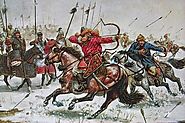
Mongol invasions and conquests progressed throughout the 13th century, resulting in the vast Mongol Empire, which, by 1300, covered much of Asia and Eastern Europe. Historians regard the Mongol raids and invasions as some of the deadliest conflicts in human history. According to Brian Landers, "One empire in particular exceeded any that had gone before, and crossed from Asia into Europe in an orgy of violence and destruction. The Mongols brought terror to Europe on a scale not seen again until the twentieth century." Diana Lary contends that the Mongol invasions induced population displacement "on a scale never seen before" – particularly in Central Asia and eastern Europe – adding that "the impending arrival of the Mongol hordes spread terror and panic." Tsai concludes that " the Mongol conquests shook Eurasia and were of significant influence in world history."

The Manchu conquest of China, also known as the Ming-Qing transition was a period of conflict between the Qing Dynasty, established by Manchu clan Aisin Gioro in Manchuria (contemporary Northeastern China), and the Ming Dynasty of China in the south (various other regional or temporary powers were also associated with events, such as the short-lived Da Shun dynasty). Leading up to the Manchu conquest of China, in 1618, Aisin Gioro leader Nurhaci commissioned a document entitled the Seven Grievances which enumerated grievances against the Ming and began to rebel against their domination. Many of the grievances dealt with conflicts against Yehe, which was a major Manchu clan, and Ming favoritism of Yehe. Nurhaci's demand that the Ming pay tribute to him to redress the seven grievances was effectively a declaration of war, as the Ming were not willing to pay money to a former tributary. Shortly afterwards Nurhaci began to force the Ming out of Liaoning in southern Manchuria.
At the same time the Ming Dynasty was fighting for its survival against fiscal turmoil and peasant rebellions. On April 24, 1644, Beijing fell to a rebel army led by Li Zicheng, a former minor Ming official who became the leader of the peasant revolt, who then proclaimed the Shun dynasty. The last Ming emperor, the Chongzhen Emperor, hanged himself on a tree in the imperial garden outside the Forbidden City. When Li Zicheng moved against him, the Ming general Wu Sangui shifted his alliance to the Manchus. Li Zicheng was defeated at the Battle of Shanhai Pass by the joint forces of Wu Sangui and Manchu prince Dorgon. On June 6, the Manchus and Wu entered the capital and proclaimed the young Shunzhi Emperor as Emperor of China.
The Kangxi Emperor ascended the throne in 1661, and in 1662 his regents launched the Great Clearance to defeat the resistance of Ming loyalists in South China. He then fought off several rebellions, such as the Revolt of the Three Feudatories led by Wu Sangui in southern China, starting in 1673, and then countered by launching a series of campaigns that expanded his empire. In 1662, Zheng Chenggong founded the Kingdom of Tungning in Taiwan, a pro-Ming Dynasty state with a goal of reconquering China. However, the Kingdom of Tungning was defeated in the Battle of Penghu by Han Chinese admiral Shi Lang, who had also served under the Ming.

The Taiping Rebellion was a massive civil war in southern China from 1850 to 1864, against the ruling Manchu-led Qing Dynasty. It was a millenarian movement led by Hong Xiuquan, who announced that he had received visions in which he learned that he was the younger brother of Jesus. At least 20 million people died, mainly civilians, in one of the deadliest military conflicts in history.
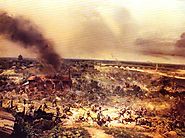
The Second Sino-Japanese War (July 7, 1937 – September 9, 1945), called so after the First Sino-Japanese War of 1894–95, was a military conflict fought primarily between the Republic of China and the Empire of Japan from 1937 to 1941. China fought Japan, with some economic help from Germany (see Sino-German cooperation), the Soviet Union (see Soviet Volunteer Group) and the United States (see American Volunteer Group). After the Japanese attack on Pearl Harbor in 1941, the war merged into the greater conflict of World War II as a major front of what is broadly known as the Pacific War. The Second Sino-Japanese War was the largest Asian war in the 20th century. It also made up more than 50% of the casualties in the Pacific War if the 1937–1941 period is taken into account.
The war was the result of a decades-long Japanese imperialist policy aiming to dominate China politically and militarily and to secure its vast raw material reserves and other economic resources, particularly food and labour. Before 1937, China and Japan fought in small, localized engagements, so-called "incidents". In 1931, the Japanese invasion of Manchuria by Japan's Kwantung Army followed the Mukden Incident. The last of these incidents was the Marco Polo Bridge Incident of 1937, marking the beginning of total war between the two countries.
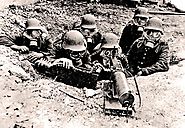
World War I (WWI or WW1), also known as the First World War, was a global war centred in Europe that began on 28 July 1914 and lasted until 11 November 1918. From the time of its occurrence until the approach of World War II, it was called simply the World War or the Great War, and thereafter the First World War or World War I. In America, it was initially called the European War. More than 9 million combatants were killed, a casualty rate exacerbated by the belligerents' technological and industrial sophistication, and tactical stalemate. It was one of the deadliest conflicts in history, paving the way for major political changes, including revolutions in many of the nations involved.
The war drew in all the world's economic great powers, which were assembled in two opposing alliances: the Allies (based on the Triple Entente of the United Kingdom, France and the Russian Empire) and the Central Powers of Germany and Austria-Hungary. Although Italy had also been a member of the Triple Alliance alongside Germany and Austria-Hungary, it did not join the Central Powers, as Austria-Hungary had taken the offensive against the terms of the alliance. These alliances were reorganised and expanded as more nations entered the war: Italy, Japan and the United States joined the Allies, and the Ottoman Empire and Bulgaria the Central Powers. Ultimately, more than 70 million military personnel, including 60 million Europeans, were mobilised in one of the largest wars in history.

The An Lushan Rebellion was a devastating rebellion against the Tang Dynasty of China. The rebellion overtly began on 16 December 755, when general An Lushan declared himself emperor in Northern China, thus establishing a rival Yan Dynasty, and ended when Yan fell on 17 February 763 (although the effects lasted past this). This event is also known as the An–Shi Rebellion or An–Shi Disturbances, as it continued after An Lushan's death under his son An Qingxu and his deputy and successor Shi Siming, or as the Tianbao Rebellion, as it began in the 14th year of that era.
The rebellion spanned the reigns of three Tang emperors before it was quashed, and involved a wide range of regional powers; besides the Tang dynasty loyalists, others involved were anti-Tang families, especially in An Lushan's base area in Hebei, and Arab, Gokturk, and Sogdian forces or influences, among others. The rebellion and subsequent disorder resulted in a huge loss of life and large-scale destruction. It significantly weakened the Tang dynasty, and led to the loss of the Western Regions.
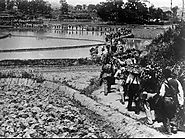
The Chinese Civil War was a civil war in China fought between forces loyal to the government of the Republic of China led by the Kuomintang (KMT) and forces of the Communist Party of China (CPC). The war began in August 1927, amidst the Northern Expedition and essentially ended when major active battles ceased in 1950. The conflict eventually resulted in two de facto states, the Republic of China (ROC) in Taiwan and the People's Republic of China (PRC) in mainland China, both claiming to be the legitimate government of China.
The war represented an ideological split (Left vs. Right) between the Communist CPC, and the KMT's brand of Nationalism. The civil war continued intermittently until late 1937, when the two parties formed a Second United Front to counter a Japanese invasion. China's full-scale civil war resumed in 1946, a year after the end of hostilities with Japan. After four more years, 1950 saw the cessation of major military hostilities—with the newly founded People's Republic of China controlling mainland China (including Hainan), and the Republic of China's jurisdiction being restricted to Taiwan, Penghu, Quemoy, Matsu and several outlying islands.
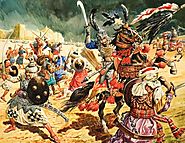
Timur (9 April 1336 – 18 February 1405), historically known as Tamerlane, was a Turko-Mongol ruler of Barlas lineage. He conquered West, South and Central Asia and founded the Timurid dynasty. He was the grandfather of Ulugh Beg, who ruled Central Asia from 1411 to 1449, and the great-great-great-grandfather of Babur Beg, founder of the Mughal Empire, which ruled parts of South Asia for around four centuries, from 1526 until 1857.
Timur envisioned the restoration of the Mongol Empire of Genghis Khan. As a means of legitimating his conquests, Timur relied on Islamic symbols and language, referring to himself as the Sword of Islam and patronizing educational and religious institutions. He converted nearly all the Borjigin leaders to Islam during his lifetime. His armies were inclusively multi-ethnic. During his lifetime, Timur emerged as the most powerful ruler in the Muslim world after defeating the Mamluks of Egypt and Syria, the emerging Ottoman Empire and the declining Sultanate of Delhi. Timur also decisively defeated the Christian Knights Hospitaller at Smyrna, styling himself a Ghazi. By the end of his reign, Timur had also gained complete control over all the remnants of the Chagatai Khanate, Ilkhanate, Golden Horde and even attempted to restore the Yuan dynasty.
Timur's armies were feared throughout Asia, Africa, and Europe, sizable parts of which were laid waste by his campaigns. Scholars estimate that his military campaigns caused the deaths of 17 million people, amounting to about 5% of the world population, leading to a predominantly barbaric legacy.
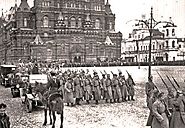
The Russian Civil War (November 1917 – October 1922) was a multi-party war in the former Russian Empire fought between the Bolshevik Red Army and the White Army, the loosely allied anti-Bolshevik forces. Many foreign armies warred against the Red Army, notably the Allied Forces and the pro-German armies. The Red Army defeated the White Armed Forces of South Russia in Ukraine and the army led by Aleksandr Kolchak in Siberia in 1919. The remains of the White forces commanded by Pyotr Nikolayevich Wrangel were beaten in the Crimea and were evacuated in the autumn of 1920.
Many pro-independence movements emerged after the break-up of the Russian Empire and fought in the war. A number of them – Finland, Estonia, Latvia, Lithuania, and Poland – were established as sovereign states. The rest of the former Russian Empire was consolidated into the Soviet Union shortly afterwards.

Life is full of challenges. Wise people choose to meet them. Foolish people choose to run from them...